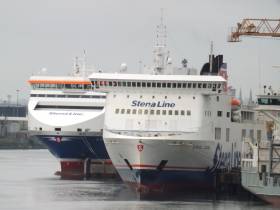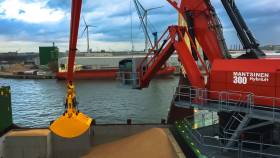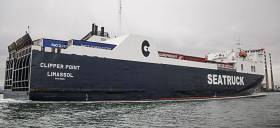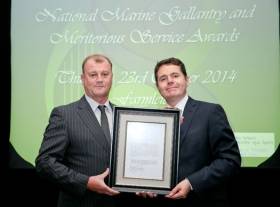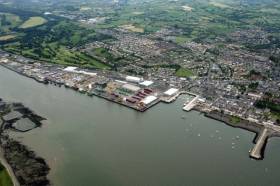Displaying items by tag: Ports and Shipping
In its first post-Brexit quarterly review of port volumes, the Irish Maritime Development Office (IMDO) offers an overview of maritime traffic on an all-island basis.
Commenting on key points in the report, Liam Lacey, Director of the IMDO said that there were significant and unprecedented changes in maritime traffic on the island of Ireland in the first three months of 2021. RoRo volumes in the Republic of Ireland declined by 13% compared to Q1 2020, while LoLo volumes rose by 11% for the same period.
RoRo volumes on ROI – GB routes fell significantly, by 31%, with a surge in ROI – EU traffic, which rose by 74%. NI – GB volumes rose by 7% in the RoRo sector in Q1. The result of these changes was that ROI – EU routes now hold an 18% share of all island RoRo volumes.
The factors driving the considerable swings in unitised trade in Q1 2021 are complex and the future makeup of the market is still highly uncertain. The most impactful factors included: the suppressive effects of severe COVID-19 restrictions on economic activity in Ireland, the UK and across Europe; a pre-Brexit stockpile of merchandise goods that drove declines on GB routes at the beginning of 2021; and concerns of disruption on the UK Landbridge which resulted in increases on ROI – EU direct services, in both the LoLo and RoRo markets. There was also a marked decline in the use of ROI ports by NI importers and exporters wishing to access markets in GB.
Passenger traffic experienced precipitous declines throughout 2020, which continued into Q1 2021, with volumes in Ireland down by 78% and volumes in NI down by 46% for the first three months. The passenger market has been more severely disrupted by the COVID-19 pandemic than any other sector of the shipping industry.
Mr Lacey cautioned that a final conclusion on the impact Brexit will have on the unitised freight and passenger markets cannot be reached on the basis of Q1 results alone. “The market is going through a phase of rebalancing, characterized by significant increases in capacity on some routes, significant reductions in both freight and passenger volumes, increased competition and considerable uncertainty. What is certain is that the shipping industry in Ireland is open, responsive, resilient and highly competitive. This is evidenced by the fact that there has been a twofold increase in capacity on direct EU services in the past 12 months, despite the effects of COVID-19 restrictions on economic activity throughout that time.”
“Ports, shipping companies and those working in the haulage, logistics and distribution sectors should be commended for continuing to provide essential services and maintain vital supply chains in the face of unprecedented challenges,” Lacey added.
The IMDO will continue to monitor these markets closely and will advise the Department of Transport and inform stakeholders with frequent reporting. The Q1 Unitised Traffic Report for 2021 is now available here.
#belfastlough - In an announcement Belfast Harbour is to invest £15 million to re-develop one of its ferry terminals.
The project, reports The Irish News, is part of a long-term investment strategy in port infrastructure will see the transformation of Victoria Terminal 2 (VT2), which currently services Stena Line's popular Belfast to Liverpool route.
The major investment will enable the terminal to handle the next generation of modern RoRo (Roll-On / Roll-Off) ferry vessels, including Stena's new E-Flexer ships.
Co Down based contractor Graham has been appointed to carry out the work, on the same day the firm secured a contract for Europe's largest infrastructure project – Crossrail.
More on the story can be found here.
Investment By Belfast Harbour Of World's Largest Hydraulic Crane to Aid Cargo Handling
#Belfast - An investment by Belfast Harbour costing £3m has led to the world's largest hydraulic crane that is due to be delivered in the Spring.
The 40-metre high Finnish machine reports Belfast Telegraph weighs 370 tonnes and can manage individual loads of up to 50 tonnes.
The harbour said 'Mantsinen 300M' will be the largest of its kind operating in any British or Irish port, enabling greater flexibility at the site, which handles 23 million tonnes of cargo annually.
The new crane will be capable of discharging up to 1,000 tonnes of bulk cargo such as grain or animal feed per hour.
For comments on the new port infrastructure can be read here.
Betelgeuse Disaster: 40th Anniversary Memorial Service
#Coastal - People in their hundreds have attended a memorial service in Bantry, west Cork, to mark the 40th anniversary of the Whiddy Oil disaster in which 50 people died.
As RTE reports, the French-owned oil tanker the Betelgeuse caught fire and exploded as it was unloading crude oil at Whiddy Island in Bantry Bay in the early hours of 8 January 1979.
A lone piper led the Irish and French relatives past dozens of floral wreaths - among them flowers from oil companies Total and Chevron - into St Finbarr's Church today where the names of the deceased were read out.
The victims - 42 French, seven Irish and one English - were remembered during a bilingual service conducted by Bishop of Cork and Ross Dr John Buckley.
For more on the disaster which took place four decades ago, click here.
Irish Shipping Volumes Increase By 5% in Q3 2017
The latest IMDO iShip Index indicates growth in shipping and port activity in the Republic of Ireland by 5% in Q3 of 2017 verses Q3 in 2016.
There was positive year on year growth across all major cargo markets. Notable however, has been the continued steady growth of Roll-on/Roll-off (Ro/Ro) trade at 5%, continuing a trend of strong growth within this sector which began in Q1 2014.
Furthermore, there has been particularly strong growth the Lift-on/Lift-off (Lo/Lo) sector at 7% overall in laden traffic. This has been driven by an 11% growth in laden exports, which is encouraging as laden exports are driven by activity in the manufacturing and agricultural industries. Laden Lo/Lo imports increased by 4% year on year.
When Lo/Lo and Ro/Ro traffic from Northern Ireland (NI) is included, all-island Ro/Ro volumes increased by 4% in Q3 2017. All-island Lo/Lo traffic grew again this quarter by 6%, with all-island imports and exports rising by 4% and 9% respectively compared to Q3 2016. NI Ro/Ro volumes grew by 2%, while NI Lo/Lo traffic grew by 3%.
The Bulk Traffic segment saw tonnage volumes increase this quarter by 4% (excluding transhipments) in the ROI when compared to the same period last year. This was driven primarily by increases in Break Bulk tonnage by 9%. Dry Bulk volumes grew by 2% while Liquid Bulk traffic increased 5% compared to Q3 2016 (excluding transhipments). However, when transhipments are included, Liquid Bulk grew by 13% this quarter compared to 2016.
Heavy Transport Ship ‘Albatross’ Moves to Port of Cork’s Deepwater Berth for Ballasting
Three new, ship-to-shore container cranes manufactured in Ireland by Liebherr and assembled in Cork Harbour are scheduled for delivery to Crowley Puerto Rico Services’ Isla Grande Terminal in San Juan later this month.
As Afloat.ie previously reported, the cranes which are currently on board the Overseas Heavy Transport (OHT) vessel ‘Albatross’, transferred from Cork Dockyard to the Port of Cork’s Deepwater berth in Ringaskiddy to take on ballast before departure to San Juan. Each crane has a capacity of 65 tons and measure approximately 65 meters tall, with an outreach of 40 meters.
Ringaskiddy Deepwater Berth is capable of handling vessels of this size and providing a fast and efficient turnaround of such vessels. Before the ‘Albatross’ departs, it will share the berth with the weekly Maersk container service from Central America, bringing the overall length of both vessels alongside to 414 metres.
Speaking about the Port of Cork’s capabilities as a “Tier 1 port of national significance” and a naturally deep water port, Commercial Manager Captain Michael McCarthy said: The Port of Cork is delighted to partner with Liebherr Cranes in selecting our Ringaskiddy Deepwater port to export their cranes to World markets. We have had an excellent relationship with Liebherr since the early 1990’s when we commissioned two cranes for our facility in Ringaskiddy. Since then we have grown our relationship with the company and all our port cranes are manufactured by Liebherr.’
He continued: ‘It is great to see Liebherr recognising our exporting capability as a deep water port.’
While in Ringaskiddy the OHT vessel, which was originally designed as an oil tanker and converted to a crane carrier, will take on large volume of water ballast in the lower ballast tanks to counteract the weight of the cranes on deck. Each crane weighs approx. 900 tons; however the weight is evenly distributed on the main deck of the vessel. The cranes are then secured firmly (welded) to the deck of the vessel and as such they form a single composite unit.
According to John Hourihan Jr., Crowley’s senior vice president and general manager, Puerto Rico Services, the electric-powered cranes will be used to load and discharge containerized cargo being carried aboard Crowley’s two new liquefied natural gas (LNG)-powered, Commitment Class Con-Ro ships.
He said: “With these state-of-the-art cranes now erected, we are taking another step toward the transformation of our terminal into the most modern and efficient port facility on the island of Puerto Rico. We eagerly await their arrival here.”
Nominations Sought for National Marine Gallantry & Meritorious Service Awards 2016
Department of Transport, Tourism & Sport is inviting nominations in respect of the National Marine Gallantry and Meritorious Service Awards 2016. The purpose of this awards scheme is to recognise outstanding acts of courage, heroism, skill and initiative in the context of marine emergency incidents. The scheme also recognises exceptional dedication to duty in the execution of Ireland’s marine emergency response. The Marine Gallantry award is presented in the form of a medal (called the Michael Heffernan Medal for Marine Gallantry, in memory of an individual who lost his life during a marine incident a number of years ago). Three levels of medal may be awarded, based on the level of gallantry involved. The medal is awarded in gold, silver or bronze.
A second award, Marine Meritorious Service Medal, may be awarded where outstanding meritorious service has been provided to, or within the remit of, the Irish Coast Guard. The person must have demonstrated exceptional dedication to duty, coupled with skill and initiative, in the execution of the service being provided.
A Marine Ministerial Letter of Appreciation may be awarded for meritorious service where outstanding dedication to duty over a career of service can be demonstrated, or for an act of particular meritorious dedication, showing skill and initiative, but which is not of an order for receipt of a Meritorious Service Medal.
The National Marine Gallantry and Meritorious Service Awards Committee is chaired by Mr Bryan Dobson of RTE. Members of the Committee include representatives of the following, the Irish Sailing Association, Irish Water Safety, Irish Harbour Masters Association, Bord Iascaigh Mhara, Department of Transport, Tourism and Sport as well as other independent members. The National Marine Gallantry and Meritorious Awards Committee will adjudicate upon the nomination received.
The first award ceremony took place in February 1999 and the awards ceremony was last held on 23rd October 2014. In this round of Awards, nominations may be considered in respect of events occurring during the period 31st August 2014 to 31st August 2016.
Details of the Awards scheme, including nomination form, are available on the Department’s website www.dttas.ie/maritime/english/marine-awards. Completed nomination forms should be submitted by Friday 9th September 2016. The submission should be comprehensive and include all relevant information (e.g. eye-witness statements, official reports, maps, charts, photographs, newspaper cuttings etc.).
2014 Award Recipients
Mr Tony McNamara and Mr. Patrick McNamara - Marine Ministerial Letters of Appreciation for Meritorious Service
Mr Ben Graham, Mr David Grant and Mr. Alexander May - Marine Ministerial Letter of Appreciation for Meritorious Service
Drogheda Coast Guard Unit - Marine Ministerial Letter of Appreciation for Meritorious Service
Mr Michael O’Regan and the crew of the Goleen Coast Guard Unit - Marine Ministerial Letter of Appreciation for Meritorious Service
Mr Jim Griffin – Marine Ministerial Letter of Appreciation for Meritorious Service
Mr Damien Dempsey – Marine Ministerial Letter of Appreciation for Meritorious Service
Mulroy Coast Guard Unit – Michael Heffernan Bronze Medal for Marine Gallantry
Shipping Review: Marine Minister Voices Concern on Brexit, UK Chancellor's Port of Call & ESPO Roadmap
#ShippingReview - Jehan Ashmore reviews the shipping scene over the last fortnight.
Following the momentous decision of the British electorate to vote 'Leave' from the EU, the Irish Minister for the Marine issued a statement in which he said “The UK exit vote also raises complex issues for the fisheries sector. Of course, the most immediate concerns for agri-food exporters centre on exchange rates”.
It was earlier this month that the UK Chancellor of the Exchequer, George Osborne visited Warrenpoint Port and local MP's in advance of the EU Referendum. The Co. Down port is where Cronus Logistics has taken over operations of Irish Sea container feeder services.
European Sea Port Organisation (ESPO) have launched a roadmap to cut out red-tape on maritime transport following the debate and implementation of the Reporting Formalities Directive (RFD).
Lo-Lo operator, Samskip launch track and trace capability for its 45ft refrigerated container fleet. Over time, the entire reefer fleet is expected to feature the track & trace capability.
RMS St. Helena having made a historic once-off visit to the Pool of London, bid farewell from Tilbury, on her final ever voyage from the UK, bound ultimately for St. Helena, some 4,500 miles away.
Rival flotilla’s on the Thames clashed over the EU Common Fisheries Policy. This led to Sir Bob Geldoff’s of the Remain camp trade insults with Nigel Farage, UKIP leader of the opposing Leave campaign.
Training vessel Empire State VI included a call to Dublin Port as part of the annual State University of New York’s sea-term. This is one of the requirements for cadets to earn a U.S. Coast Guard license.
Cronus Welcomes UK Chancellor Osborne to Warrenpoint Port
#BREXITport? - The UK's Chancellor of the Exchequer George Osborne reports MultiModal, met senior executives from Warrenpoint Harbour Authority (WHA) and local MP's during a visit to the Co Down port yesterday.
The Chancellor met MP Margaret Ritchie, along with Nicola Walker and managing director of Cronus Logistics, as previously reported on Afloat.ie, new operator of Irish Sea container feeder services. This includes the only Ireland-Wales service connecting Dublin and Cardiff along with Belfast and Bristol.
The Chancellor was shown round the docks and observed ro/ro and containerised operations along with the discharge of bulk grain ships. He was also shown timber that is imported through Warrenpoint but ultimately is transported across the land frontiers into the south of Ireland.
“We are pleased that the Chancellor recognises the importance of Warrenpoint as a strategic port for imports and exports in Ireland,” says Nicola.
Speaking to the media during his tour he said, “I’m here at Warrenpoint and it’s a very practical demonstration of the fact that Northern Ireland has the only land border with an EU country… If we quit the EU, this is going to be the border with the EU.”
He later crossed the border on a lorry delivering timber into Dublin.
Key Trends Identified by ESPO in Port Governance
#PortGovernance - Independent management, masterplanning and digitalisation are among some of the trends in EU port governance highlighted by the European Sea Ports Organisation (ESPO) in its 2016 Fact-Finding Report.
Port Strategy writes that the report states most port authorities in Europe remain publicly owned. Full ownership by the state or by the municipality remains predominant, while only a few port authorities combine ownership of different government levels. Mix public-private ownership, meanwhile, is still much rarer and exists in just a few European countries.
The report noted, however, that seaports are moving towards more independent private-like management. “Compared to 2010, more port authorities are structured as independent commercial entities and operate in a commercially-orientated manner. In 2016, they account for 51%of the respondents. Next, 44% or port authorities are still independent public bodies with their own legal personality and different degrees of functional and financial dependency from the public administration,” it said.
To read more, click here.


























